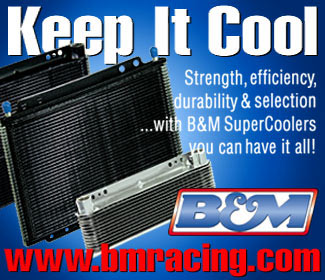
So, the question remains, just how will the "spec" engine,
rev-limiter, supercharger overdrive, a nitro percentage rule
and all of the other rules benefit or harm the fuel classes?
The general consensus from the tuners and owners I spoke
with was that, with the exception of the safety rules implemented
to improve driver survivability, all of the changes have
just made the classes more expensive to compete in. One tuner
I spoke with from a so-called "budget" operation
explained how the rules had made it more difficult for them
to be competitive. He explained that before the 85-percent
nitro rule and the spec supercharger and supercharger overdrive
rule, he had tuning options that allowed him to be competitive
with less than "primo" parts.
"If my combination was a little down on power I'd put
a couple of more percentage points of nitro in my fuel mixture
or if the blower was tired I'd increase my blower overdrive
by a couple of percentage points and wake the engine up," this
tuner explained. "Now I don't have those options. Now,
with the 85 percent nitro rule, if I really want to try to
be
ADVERTISEMENT
 |
competitive and have any chance to win, I have to spin
my motor faster and put in more fuel volume than I ever did
before. I'm wearing my parts out a lot faster than I did
before because of the rule changes. Now in order to be really
competitive I'm forced to put on a new supercharger, new
tires, and fresh heads for every round."
You can bet that a "spec" blower with a maximum
overdrive limit is the reason that the best financed teams
all have blower dynos, and the teams that can't afford one
will suffer on raceday. Regardless of the fact that a blower
is built to a certain spec and restricted to the amount of
overdrive, some will flow more air than others. The well-financed
teams can buy 10 or 20 blowers, dyno them to find the best
ones. They keep the best and the not so good ones will be
sold to the less-financed teams. The same scenario will apply
to cylinder heads, fuel injectors, and everything else that
NHRA issues a spec for.
As one crew chief told me, "If they ever put a spec
on fuel pumps, they'll all cost $5000 and will be built by
watchmakers in Switzerland."
According to NHRA sources, Tom Compton is the driving force
behind the decision to implement a spec engine and a moratorium
on engine development for the fuel cars. His belief, as I
understand it, is that those measures will somehow make the
classes more affordable and attractive to potential new sponsors.
He seems to think that NHRA should be aiming for closer competition,
not better performances.
Unfortunately, history has shown over and over that just
the opposite is what generally results from a spec engine
program. The best examples I can think of are restrictor
plate spec engines in NASCAR and NHRA's 500-inch Pro Stock
engines. If you could buy one of these engines from a competitive
team they'd cost you way over $150,000.
The NHRA is in a terrible dilemma with their premier attraction
classes. They're too fast, too dangerous, too unreliable,
and apparently too expensive for most new racers and sponsors.
They also don't seem to be very popular with the average
motorsports fan, based on the attendance and TV figures.
Tom Compton and his management team know they have major
hurdles to overcome. They also are painfully aware they have
to try something to improve their product.
Perhaps rev-limiters, "spec" engines and 85-percent
nitro are the answer. But so far at least, the racers don't
think so and the fans haven't voted.
|

